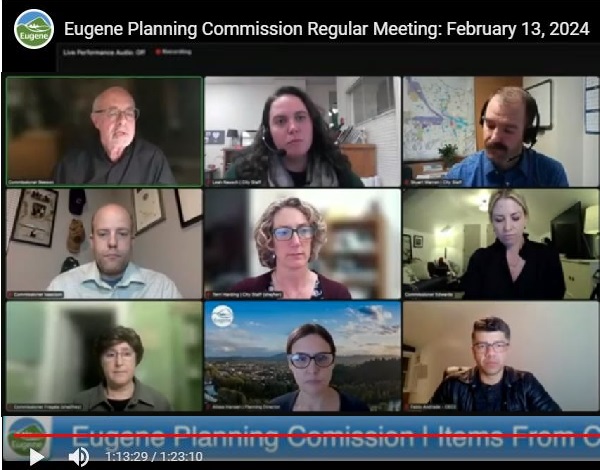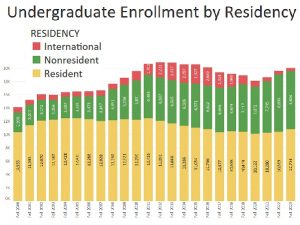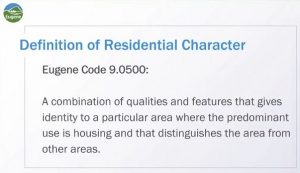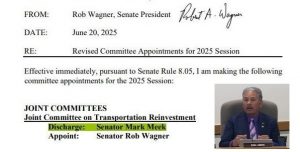Eugene planning commissioner asks about Goal 1 evaluation
12 min read
The Eugene Planning Commission votes to launch community engagement for urban growth strategies, the city’s next big project. But did they ever evaluate the last one? And after failing to provide an evaluation plan 20 years ago, as required in state Planning Goal 1, do they even have an evaluation plan? On Feb. 13:
Terri Harding (Eugene Planning): I’m Terri Harding. I’m the principal planner for Community Planning and Design with the city of Eugene.
[00:00:25] In your role serving as the city’s Committee for Citizen Involvement, we are looking for the Planning Commission to provide feedback on, and to approve or approve with modifications, the community engagement plan during this meeting. I’d like to turn it over to Leah.
[00:00:41] Leah Rausch (Eugene Planning): My name is Leah Rausch. I am an associate planner on the Community Planning and Design team.
[00:00:47] Urban growth strategies, this umbrella project, will identify the tools, actions, policies, and land needed for the next 20 years to support living wage jobs and housing that everyone can afford.
[00:01:00] This work will result in studies of what land is actually available in Eugene, updates to our Envision Eugene comprehensive plan and other adopted city plans and land use regulations. We’ll have a parcel-specific land use designation map and an evaluation of whether there is a need to expand the urban growth boundary or the UGB.
[00:01:23] As you all have heard, in 2022 the state adopted rules establishing the Climate Friendly and Equitable Communities, or CFEC program. The CFEC rules include a specific requirement to conduct an engagement-focused equity analysis…. based on the stories and lived experiences of historically marginalized community groups.
[00:01:41] You may be wondering why it’s important for us to center marginalized voices in this planning work and ultimately in decision-making. There’s a well-documented history of decades of discriminatory housing and land exclusion policies that have kept communities of color from opportunities to build generational wealth in housing and land ownership and access affordable and quality housing near schools, grocery stores, jobs, transportation, and clean air and water.
[00:02:07] These harmful policies from the past are still felt in Eugene today, including the historic exclusion of non-white people from Oregon, the displacement of the Ferry Street Bridge or the Over the Bridge community, and the exclusionary roots of single-family zoning and restrictive covenants.
[00:02:24] The Housing Production Strategy, or the HPS, must summarize how the selected priority actions in combination with other city actions will achieve equitable outcomes related to the location of housing, fair housing and housing choice, housing options for residents experiencing homelessness, affordable home ownership and affordable rental housing and gentrification, displacement and housing stability.
[00:02:51] Stuart Warren (Eugene Planning): The purpose of the community engagement plan is to guide how the city engages the Eugene community during the urban growth strategies project. The plan outlines engagement goals, the appropriate level of involvement for community members based on their ability to impact project outcomes, and illustrates the principles that staff are committed to during engagement.
[00:03:10] The plan describes opportunities for people to engage in the different phases of the project. It details how different individuals and organizations could participate in the project and ways that they can stay informed, and clearly communicates the city’s commitment to equity through community engagement.
[00:03:27] Engagement will also target historically marginalized community groups to ensure that their feedback and concerns are understood and articulated alongside technical analysis.
[00:03:35] With your approval, staff is proposing that we start targeted engagement in the next month with activities like social engagements, working group meetings, interviews, and meetings with the Envision Eugene Technical Advisory Committee or EETAC.
[00:03:50] Planning Commission’s role is to engage at key points in the project and to provide policy direction and ultimately make a recommendation to city council.
[00:03:57] Staff have already begun organizing events and currently have 29 people signed up to attend the first meeting in March.
[00:04:04] Individual and small group interviews will augment engagement by reaching out to specific stakeholders who have not been represented in the engagement process. Through this activity, staff will meet people where they are and ask pointed questions about tools, actions, strategies, and policies. Interviews are an important part of engaging historically marginalized community group members in this project.
[00:04:24] And we also have some really exciting news to share with you. As of yesterday, the urban growth strategies project was just notified that we will receive additional funding to increase our equitable engagement beyond what was included in the community engagement plan. As soon as we know more information, we’ll bring you all into the loop.
[00:04:41] Next steps include gathering feedback from the Planning Commission and approval of the community engagement plan tonight. If approved, staff will host pre-engagement conversations with community partners to gather feedback. This feedback will help the project team tailor implementation of this plan to better fit the needs of the community. This step is a bit different than what staff has done before and is an important part of tailoring the plan to meet the needs of the community.
[00:05:07] Lastly, we plan on returning to the Planning Commission on May 15. To help ensure that the project achieves the desired outcomes, staff is asking for the Planning Commission to consider what, if anything, is missing from the community engagement plan, what would the Planning Commission like to see done differently, and does the Planning Commission have any suggestions about the best way to implement the community engagement activities in the plan.
[00:05:32] Tiffany Edwards (Planning Commission chair): Sometimes I hear anecdotally that people that participate in the city’s processes to provide feedback, end up not feeling heard when a different decision than what they have personally maybe weighed in on ends up being not what is recommended to council or whatnot.
[00:05:51] And so I think that what I’d like to see is really straightforward clarity about what is being asked of the public so that there is no question about asking them how they feel about something, when at the end of the day, there are mandates involved and we can’t, there’s nothing we, you know, we can do as a city; we really have to implement certain things.
[00:06:14] Leah Rausch (Eugene planning): It’s a great point, Commissioner Edwards. I think when we’re looking at state-mandated work, we want to be realistic about where the community has leverage and influence and where we’re just implementing state mandates. We will really be trying to focus our engagement on those pieces that the community can kind of meaningfully involve and influence.
[00:06:37] The other tool that we lean on a lot is the International Association for Public Participation ‘Spectrum of Public Participation.’ So it basically says, ‘How deep are you going to engage with people based on how much influence they can have over the outcomes?’ and ‘What tactics kind of help you line up those two things?’
[00:07:00] So that’s kind of the framing that we use for the engagement goals that are included in the plan. And something we try and think a lot about is, is this an informing opportunity where we’re really just saying, ‘Hey community, this is happening, here’s how you can learn more,’ versus deeper engagement, where we want to work really closely with folks to influence project outcomes all the way through to decision-making.
[00:07:26] And I think your last point was around, you know, people understanding what happened to what they told staff, versus what gets ultimately decided on. And that is certainly something we need to commit to, is that transparency.
[00:07:42] We’ll be developing a few public community engagement kind of summaries throughout the three years that summarize: ‘Here’s what we heard; here’s all the tactics; here’s who we talked to;’ a summary of not just the big themes, but really more of the nuanced details that we heard from different groups and perspectives, and, ‘Here’s what we did with that information and feedback.’
[00:08:03] And there’s, actually the Housing Production Strategy has some very specific rules from the state of how we have to connect what we heard in engagement to our policy priorities and actions and actually like draw that connecting line between them.
[00:08:20] Ken Beeson (Planning Commission): I think the hardest part of all this is to really engage with the people who are most impacted.
[00:08:27] I kept thinking about renters. I even went back and I looked, I think it was our December presentation, about the severely rental-cost-burdened community that we have. And like 34,000 renters out there. And we’re one of, I guess, a handful of communities in Oregon that has this situation, and I’m thinking as part of all of this reaching out and connecting with that whole community and hearing from them and learning from them. They’re not really heard from that much. I think of them as being a bit marginalized.
[00:09:06] John Q: He also recommended sustained engagement.
[00:09:11] Ken Beeson (Planning Commission): As opposed to maybe single interviews, it would be good if you can engage with some people over a period of time, help them understand what this is all about, give them a chance to kind of talk to their friends and neighbors and that whole thing.
[00:09:29] Leah Rausch: Commissioner Beeson, your point about emphasizing renters is well taken. They’re on that list of historically marginalized communities, but certainly, especially when we’re talking about the housing planning components, a really important group for us to check in with.
[00:09:45] We’re eagerly awaiting the results of the renter experience survey that Community Development did. They’re wading through the initial results of that and that will give us some really great information on kind of housing needs for specifically for renters, but certainly wanting to prioritize them through our other engagement tactics as well.
[00:10:08] I’ll also say, I think your point around that sustained engagement with historically marginalized groups or with a more representative group is well taken. We don’t currently in this plan have kind of an equity panel model.
[00:10:24] As Stuart said, we did recently hear we have some more resources to put towards that work, whether it be more translation, more of those like focus groups and interviews, getting into community through community-based organizations and actually through partnerships with nonprofits and other community groups, trying to kind of sustain that relationship-building that kind of gets to what you’re talking about.
[00:10:51] Dan Isaacson (Planning Commission): This is definitely moving in the right direction in terms of how we’re engaging and also how we’re listening to change the process each time we have this come up. So we’re not following the same prescriptive process, we are learning from it, which has been kind of my mantra since HB 2001. And how are we changing the method by which we’re reaching out to folks so that we’re learning?
[00:11:14] I think that one thing that would be really helpful is setting out what the goals are ahead of time and allowing people to have some say into whether or not that’s an efficient or effective goal that they’re kind of setting the measuring stick at.
[00:11:30] Because I think part of the problem that we continually have when we get to the end of one of these scenarios is we will hear that the measuring stick isn’t universally accepted.
[00:11:40] And so if we all agree on that or at least we all know what the measuring stick is going into it, then at the end of it we can say, ‘Look, we put this up here, we had a conversation about what the measuring stick was going to be, we had a conversation about what the metrics were going to be and we achieved them.’
[00:11:55] I think that that adds a little bit another layer of transparency onto it as well.
[00:12:00] The only other thing I was going to suggest is you know larger apartment complexes within the city usually have community rooms and in addition to doing the neighborhood association meetings which are typically at night so it’s going to involve staff time after hours, having some sort of announcement or process at some of the larger apartment buildings where all they’re all collective renters to be able to have that kind of feedback, I think that that would be an interesting, a new approach to this whole process.
[00:12:31] Lisa Fragala (Planning Commission): I’m really glad you’re reaching out to youth. I don’t know how you define that.
[00:12:39] Leah Rausch: That’s a good question… I would say like the 18 to 30, even, like young adults and students. We’re working with a few community collaborators who are University of Oregon undergraduate and graduate students who will really serve as liaisons to that community, help us shape engagement that is resonant and interesting to younger people and more diverse people, more racially-diverse people, I should say.
And really specifically that type of engagement because there are often groups who aren’t going to show up to a citywide open house that’s hosted by the city directly, or participate in a survey, or some of our more traditional methods.
[00:13:26] In addition to that, we are working with the city manager’s office to look at the mayor’s Youth Advisory Council to try and work more closely with them and that is high school-age students.
[00:13:40] Lisa Fragala (Planning Commission): And I would be remiss if I didn’t point out that Lane Community College has a much more diverse population of students than the U of O does. So I would really hope we would probably prioritize engagement there as well.
[00:13:58] But I also think of reaching out to younger people in their 30s. You know, young families who have children, right? These are community members that are invested in how our community grows and develops and are raising their children here. So I would encourage you to use the city’s school district or school districts as access points.
[00:14:28] If we want to engage with people in parts of the city that have historically not had as much engagement or as much of a voice in these opportunities, we may need to have additional open houses or social engagements in those areas. And, you know, I think many of those areas tend to be west and north, and we know where the predominant participation tends to be. I really appreciate the effort to reach out to renters.
[00:15:02] John Q: With the planning commission’s responsibility for evaluation under Goal 1:
[00:15:07] Ken Beeson (Planning Commission): I actually went back and read Goal 1. I haven’t really looked at that for a while, but it talks in there about, in terms of citizen involvement and the state planning goals, but talk in there about feedback, the idea that everybody who gives comment, when you’re taking public comment, is that there is some sort of response or feedback given. Do you guys talk about that a bit?
[00:15:40] Leah Rausch: Yeah. At a high level, I would say we tried to build out this timeline to provide some level of asking the community for feedback and response, going and doing our due diligence and work to kind of refine and then coming back for that second round to say, ‘Here’s what we heard. Here’s how it’s reflected. Do we get it right? Give us more of your feedback and response.’
[00:16:08] So a lot of the engagement right now is kind of built in those two rounds in order to share with the public how their feedback was incorporated. So that’s kind of about it in a general sense.
[00:16:23] And the community engagement summaries will certainly be doing that kind of, ‘Here’s what we heard, here’s how we’re responding to it or incorporating it.’
[00:16:34] Terri Harding (Principal planner): And also by way of example, we’ve been using Engage Eugene for a few years now and there’s a lot of different ways to ask questions and receive feedback from staff. So we do have some experience with the Engage Eugene tool and we try to get back to people as quickly as possible.
[00:16:50] And sometimes a response will be repeatedly given. The same feedback will be given to the city. And we have ways to answer that too so that we’re not getting stuck in a cycle of a comment that has been asked and answered, continuing to take a lot of staff time.
[00:17:12] We do want to provide fair opportunity for public comments and make sure that we’re keeping enough capacity to respond to input as it comes in and not belabor comments that come in that actually have been answered.
[00:17:30] Ken Beeson (Planning Commission): It’s just the idea that as people are participating in the process and giving their input, they can, and it’s maybe been mentioned by some others here tonight, but the idea that they can kind of feel like they’ve been heard, and part of that is maybe something coming back.
[00:17:51] So the only other thing that kind of jumps out of here is that there’s evaluation done or there’s sort of like a loop. So we do a community engagement plan and it goes through our work over a period of time and then there is some sort of evaluation done.
[00:18:12] John Q: The city hopes to be more clear about where planners are forced to follow state mandates. They hope to focus public engagement where the community can make meaningful choices.
And a planning commissioner re-reads the state of Oregon’s Planning Goal 1, and notes the requirement for an evaluation process. We asked for a copy of the letter describing Eugene’s evaluation mechanism, but neither the city nor the state could find it.



